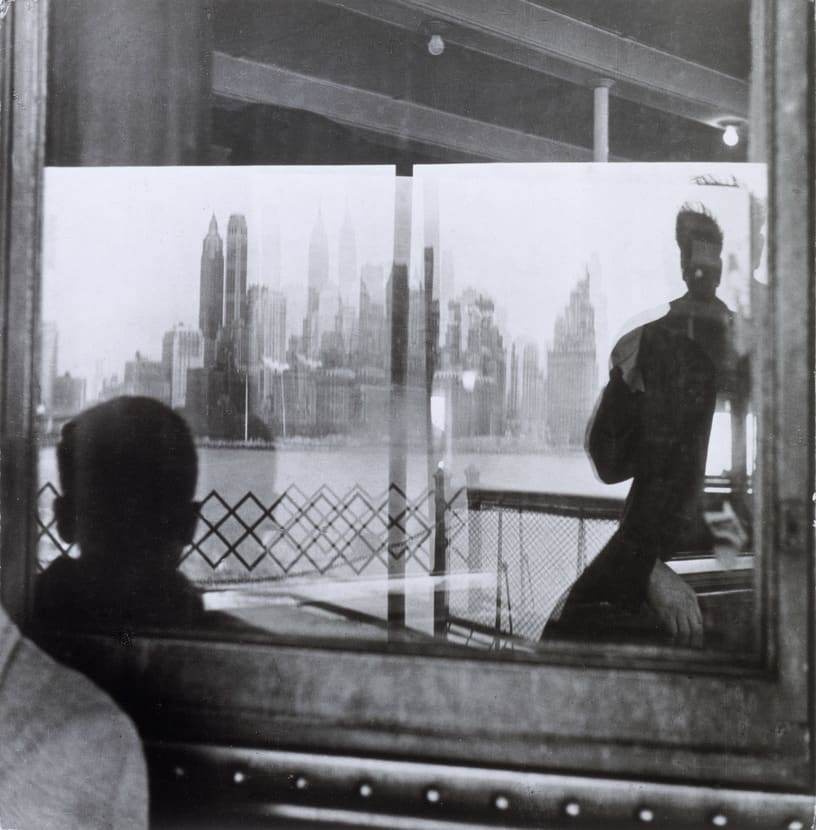
- Artist/Maker:
- Louis Faurer
- Bio:
- American, 1916-2001
- Title:
- Staten Island Ferry
- Date:
- 1946, printed c. 1980
- Medium:
- Gelatin silver print
- Dimensions:
- Sheet: 11 × 14 in. (27.9 × 35.6 cm) Image: 8 × 8 in. (20.3 × 20.3 cm)
- Credit Line:
- Purchase: Gift of Judith and Jack Stern
- Accession Number:
- 2000-57
Not On View
Louis Faurer's quiet and melancholy images capture individuals at their most contemplative moments, even amid the tumult of the big city. In the presence of his photographs, the viewer feels privy to the secret world of their subjects.
Faurer grew up in a Polish Jewish immigrant family in Philadelphia. Before attending the School of Commercial Art and Lettering in 1937, he earned money by drawing caricatures in Atlantic City, New Jersey, and in his spare time took photographs on the boardwalk there. In 1946, he began commuting to New York, where he took freelance fashion photographs for publications including Harper's Bazaar and became friendly with the photographer Robert Frank, who allowed him to use his Manhattan loft and darkroom. For the next thirty years, Faurer continued to do fashion photography, which sated his aesthetic sensibility and perfectionist inclinations, for publications such as Flair, Vogue, and Seventeen. He also developed his own photographic techniques. Although he did not actively promote his own work, advocates such as the actress Viva, with whom he had been romantically involved in the 1960s, curator Walter Hopps, and dealer Deborah Bell have played integral roles in preserving his work and bringing it to the fore.
Faurer often used reflections and double exposures to create stunning visual juxtapositions and compositions. In Staten Island Ferry, Faurer captured the ghostly panorama of New York obscured by the window of the ferry. He provided clues that there is a man seated on a bench in front of the window by showing a segment of a suited shoulder and a silhouette of a head. We can only assume that the figure on the right is the photographer, but who is the man that his shadow makes visible? And can he see the majestic cityscape that the photographer is showing us? Without seeing their faces, we perceive the men as entrenched in the skyline before them and thoroughly isolated from each other.
Faurer grew up in a Polish Jewish immigrant family in Philadelphia. Before attending the School of Commercial Art and Lettering in 1937, he earned money by drawing caricatures in Atlantic City, New Jersey, and in his spare time took photographs on the boardwalk there. In 1946, he began commuting to New York, where he took freelance fashion photographs for publications including Harper's Bazaar and became friendly with the photographer Robert Frank, who allowed him to use his Manhattan loft and darkroom. For the next thirty years, Faurer continued to do fashion photography, which sated his aesthetic sensibility and perfectionist inclinations, for publications such as Flair, Vogue, and Seventeen. He also developed his own photographic techniques. Although he did not actively promote his own work, advocates such as the actress Viva, with whom he had been romantically involved in the 1960s, curator Walter Hopps, and dealer Deborah Bell have played integral roles in preserving his work and bringing it to the fore.
Faurer often used reflections and double exposures to create stunning visual juxtapositions and compositions. In Staten Island Ferry, Faurer captured the ghostly panorama of New York obscured by the window of the ferry. He provided clues that there is a man seated on a bench in front of the window by showing a segment of a suited shoulder and a silhouette of a head. We can only assume that the figure on the right is the photographer, but who is the man that his shadow makes visible? And can he see the majestic cityscape that the photographer is showing us? Without seeing their faces, we perceive the men as entrenched in the skyline before them and thoroughly isolated from each other.
Information may change as a result of ongoing research.